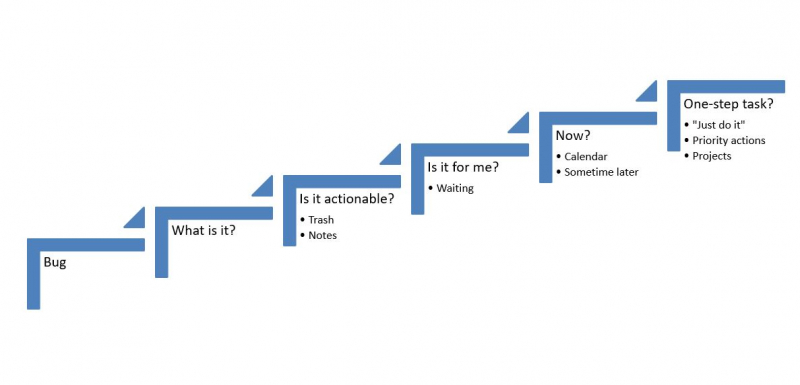GTD or Getting Things Done: A World Without Worries Over Forgotten Things
This is the third part of this series of blogs. You can check the first blogs here and here. Last time, we created a full basket of tasks. And now we will take steps which can be exhausting at first, but which you’ll get used to. We have to empty our basket!

First of all, assume that you have collected everything that has your attention! I will remind you that a basket is something that we have filled with bugs that distract your mind. Understand that emptying your basket doesn’t mean actually doing all the tasks and projects that you’ve collected. It just means identifying each item and deciding what it is, what it means, and what you're going to do with it. The main rule here is "one crisis at a time". We are working only with one "bug". So, here is the algorithm for every "bug".

1. What is it?
At this point, you should remember what you meant by writing that one "bug". Imagine you have written "Call friend". But what friend did you mean exactly? And why? Write every needed detail and continue.
2. Is it actionable?
You could have written down some cool thoughts that you can’t do anything with. Or maybe you wrote down the menu of your favorite restaurant. It’s time to make it clear if you can do something with this bug. If the answer is "YES", you can move to the next point and skip 2.1. and 2.2. parts :) If the answer is "NO", you need to understand if the information you are holding is useful or not.
2.1. No. Trash.
If you can’t do anything with this bug and it’s useless, then just put it in "Trash". Approximately 30% of your bugs will be here.
2.2. No. Notes
What you hold in your hands can be background information and you wouldn’t need to do anything with it, but it’s useful. It will fall into a special list of "Notes".
3. Is it for me?
If we have reached this point, it means that we have an actionable task in our hands about which you understand everything. Ask yourself, "Who should do this task? Me?". Maybe you need to delegate this task. "My wife needs to go to the bank and reissue her card", "I should hire someone to renovate my office in a week", etc.
3.1. No. Delegation.
If you don't need to complete the task, delegate it immediately. After that, put it in a special "Waiting" list, adding a note there about who is now engaged in this task and when it is expected to be completed. If it is physically impossible to delegate a task right now (e.g. there is no connection), put the task "Delegate something to someone" in the basket, and in due time this task will pass all the processing stages. By the way, the task "Delegate something" is still yours, not someone else's. Also, the "Waiting" list includes tasks that another person is already busy with, and for some reason you still put it here. For example, you wrote a letter to someone, and you are waiting for their answer. Put this task in the "Waiting" list, along with the name of the person and the date on which you started to wait for their reply.
4. Now?
If you have reached this point, then the task in your hands is clear to you, you need to do something with it, and, moreover, it is for you. Ask yourself the question: "Should I do this now?". In this situation, "Now" is a very subjective thing. So, answer this question subjectively. For me, for example, "Now" is approximately two weeks.
4.1. No. Calendar.
If the task has a specific date and/or time, put it in the calendar. The calendar is one of your working tools, along with the "Notes" and "Waiting" lists. This is a training course that you have already decided to go to? These are scheduled meetings? These are your purchased tickets for a plane, a train, or a concert? You can use Google Calendar for that purpose.
4.2. No. Sometime later.
If you need to do something with the task that is just for you, but not now, and it is not clear when you need to do it, then it falls into the "Sometime later" list. "Sometime later" doesn't mean "Never", it means "sometime later". It will contain all your dreams, all the things you would like to do someday, all the super interesting and important things in your life.
5. One-step task?
So, you have a task about which you know everything, with which you need to do something, just for you, and now. Now the most difficult question is: "Is it a one-step task"? You are probably overestimating the class of one-step tasks. The task "Clean the floor" is not a one-step task if you don’t have a mop in your house. You'll have to buy a mop first, and then wash the floor. The "Go to the movies" task is not a one-step task if you don't know which movie to watch. You'll have to choose a movie first. But the task of "Going to the cinema to see Spider-Man" is also not a one-step one. First, you need to choose a movie theater and a date of the show. But, maybe, you have a one-step task after all?
5.1. One-step task that needs less than 2 minutes.
If you have a one-step task that needs less than 2 minutes, just complete it immediately!
5.2. One-step task that needs more than 2 minutes.
So, we have a one-step task in our hands. Let's ask ourselves two questions again" "Do I need to do it?" and "Now?" Again, if your answer is "NO" to these questions, we need to put this task in "Waiting", or "Calendar", or "Sometime later". If the answer is "YES" to both questions, then we have a hard case on our hands. A task that we understand, that we need to do now, and it is one-step, but it takes more than two minutes or it can't be performed under the current conditions… Damn, this is the very task that you will have to do! This is where our journey ends, this is the dead end of our task analysis process and we need to start completing this task. This task is included in the list of "Priority actions".
5.3. Projects.
A project is the opposite of a one-step task. All projects should be in the "Projects" list. Projects should include three important parts: completion criteria, plan of steps, and the first action.
Completion criteria should be clear and precise. E.g. "I want to clean my house" should be "Everywhere I look should be so tidy that it makes me happy". You get me :) It is very important to make your criteria as precise as you can because there are lots of tasks that are incomplete as you don’t know why you want to achieve this or that task.
The plan of steps should have every step your plan contains. Your plan should be consistent and it should have as many details as it’s possible.
And the last part of the project is your first action. The first action should be a one-step task. All the others can be not one-step tasks, but the first one should be. Also, your first action should be pretty easy to complete because our goal is to just start your project.
So, now we need to analyze every "bug" using this algorithm. And in the next and the last part of this blog series, I will write about how to keep this system alive.
